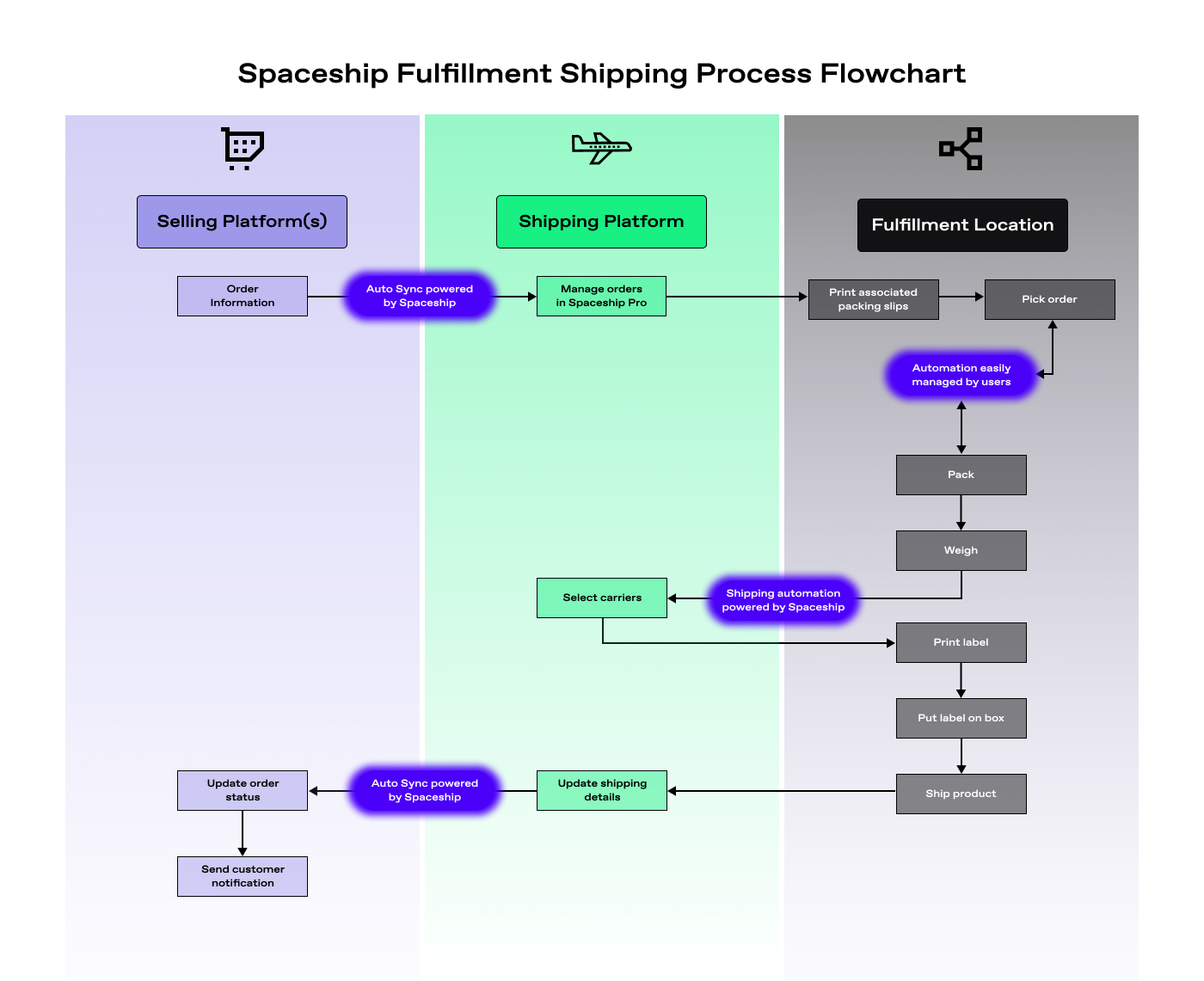
Operating an eCommerce business introduces all kinds of logistical challenges. As you scale from packing boxes yourself to managing large volumes of orders, fulfillment can quickly become complex and unwieldy. Delayed shipments, order errors, and inventory mishaps end up eating into both profits and customer satisfaction.
That’s where order fulfillment software comes in. Modern solutions can automate fulfillment workflows, provide inventory control, integrate shipping, and give you the visibility you need to optimize operations. In this guide, we’ll cover:
- Key features to look for in order fulfillment systems
- Benefits for growing ecommerce businesses
- How software can improve inventory management
We’ll also see how Spaceship leverages fulfillment software to simplify logistics for online sellers. Let’s dive in!
Must-Have Fulfillment Software Features
Order fulfillment tools on the market offer an array of capabilities. As you evaluate options, here are some key features to look for:
- Integration with eCommerce platforms like Shopify, Amazon, and custom storefronts. This allows orders to flow directly into the fulfillment system.
- Accounting software integration to sync order and inventory data with your books.
- Scalability to grow as your business expands.
- Warehouse management for picking, packing and inventory control.
- Shipping integration to purchase labels, compare rates across carriers, and track packages.
- Custom workflow configuration to match your unique order processes.
- Analytics and reporting to identify trends and optimize operations.
- B2B and B2C order capabilities to support different order types.
- Ecommerce-focused features like branded packing slips and emails.
- Onboarding and training to get up to speed quickly.
- Intuitive interface for easy daily use.
Also consider the level of support and how exceptions like backorders are handled. The right software will help you work smarter, not harder.
Connect with Spaceship Fulfillment.
Get 30 days free storage when you book demo.
Why Small Businesses Need Fulfillment Software
For small eCommerce businesses, fulfillment software provides major benefits:
- Automates manual tasks like order processing, address label printing, and status updates.
- Centralized dashboard to manage orders from anywhere.
- Inventory tracking across all warehouse locations.
- Increased order accuracy by reducing errors.
- Faster order processing with workflow automation.
- Lower labor costs with fewer warehouse staff needed.
All of this boosts productivity and allows you to scale without added headcount. Software handles the busywork so you can focus on strategic growth.
Learn more: Small Business eCommerce Fulfillment: Simplifying Order Processing for Success
Maintaining Order Through Inventory Management
As fulfillment volumes grow, inventory management becomes both more crucial and more challenging. Fulfillment systems provide robust tools to give you control over stock including:
- Real-time tracking across warehouses.
- Reorder point alerts to prevent stockouts.
- Forecasting and analytics to predict inventory needs.
- centralized inventory visibility across locations.
- Bin management for putaway and picking.
- Label printing for bins and orders.
With synchronization and organization powered by software, it’s far easier to ship promptly while keeping costs efficient.
Tips for Peak Season Inventory Management
Inventory management could be a nightmare during peak seasons like summer sale, Amazon Prime Day, Black Friday, etc. Here are some tips:
- Plan ahead. Use historical sales data and industry trends to forecast demand for your products. This will help you to determine how much inventory you need to order and when to order it.
- Optimize your inventory levels. Make sure you have enough inventory on hand to meet demand, but don’t overstock. Overstocking can lead to increased costs, such as storage and obsolescence costs.
- Track inventory levels closely. Use a real-time inventory management system to track inventory levels across all of your channels. This will help you to identify any potential stockouts and to take corrective action immediately.
- Use a variety of suppliers. Don’t rely on a single supplier for all of your inventory needs. This can reduce your risk if one supplier has a delay or stockout.
- Have a contingency plan in place. Even with the best planning, things can go wrong. Have a contingency plan in place in case of unexpected events, such as a supplier delay or a natural disaster.
- Use a first-in, first-out (FIFO) inventory management system. This will help to ensure that your oldest inventory is sold first, which can help to reduce obsolescence costs.
- Offer promotions on slow-moving items. This can help to clear out your inventory and make room for new products.
- Consider outsourcing your fulfillment. This can help you to free up your staff to focus on other tasks, such as sales and customer service.
- Communicate with your customers. Keep your customers updated on the status of their orders and let them know if there are any delays.
By following these tips, you can help to ensure that you have the inventory you need to meet customer demand during peak season.
Don’t miss out the in-depth analysis of 2023 trends and opportunities, everything you need to know about eCommerce strategy for BLACK FRIDAY 2023, click here to download the report for FREE!
Use FIFO to Better Manage Your Inventory
FIFO stands for First in, First out. It is an inventory management method that assumes that the oldest inventory is sold first. This is in contrast to other inventory management methods, such as LIFO (Last in, First out), which assumes that the newest inventory is sold first.
FIFO is a popular inventory management method because it is simple to implement and understand. It is also a good method for businesses that sell perishable products, as it helps to ensure that the oldest products are sold first before they expire.
To implement FIFO, businesses need to track the cost of each unit of inventory. When a sale is made, the cost of the oldest unit of inventory is used to calculate the cost of goods sold. This helps to ensure that the business is accurately reporting its profits and losses.
Here is an example of how FIFO works:
- A company purchases 100 widgets for $1 each on January 1st.
- The company purchases 100 more widgets for $1.25 each on February 1st.
- The company sells 100 widgets on March 1st.
Under the FIFO inventory management method, the company would use the cost of the oldest widgets (purchased on January 1st) to calculate the cost of goods sold. This would result in a cost of goods sold of $100.
Learn more: Inventory Management 101: A Deep Dive into FIFO Method for eCommerce Fulfillment Warehouses
Spaceship Powers Simplified Fulfillment
Spaceship understands the logistical headaches online sellers face at scale. Our fulfillment software forms the core of an end-to-end solution including:
- Book storage online
- Simply book your goods online and we’ll receive and inspect them to ensure they arrive at the warehouse in perfect condition.
- Real-time inventory control
- Spaceship fulfillment platform provides real-time updates on your shipment status, inventory, and more. We’ll also send automatic email and SMS notifications, so you can manage your goods remotely anytime, anywhere.
- Partial fulfillment
- With Spaceship’s warehousing and logistics system, users can easily update shipping instructions at any time. Even for orders with only one item available in our warehouse, you can still arrange the shipment in advance so that you customers will not be waiting too long.
- Warehousing
- Starts from just 6 boxes
- Monthly storage fees
- Scales up as you grow
- Shipping
- Rates from top carriers
- Discounted prices
- Global shipping services
 Handling fulfillment in-house becomes chaotic as orders pour in. The right software provides the systems and structure you need to streamline logistics, avoid headaches, and delight customers.
Handling fulfillment in-house becomes chaotic as orders pour in. The right software provides the systems and structure you need to streamline logistics, avoid headaches, and delight customers.
From automation to analytics, modern tools give you visibility and control over the entire order lifecycle. Fulfillment software enables you to sustain rapid growth without the grind.
Now is the time to upgrade from makeshift spreadsheets and storage rooms to robust fulfillment tech. Check out solutions like Spaceship to see how software can transform your ecommerce operations today.








